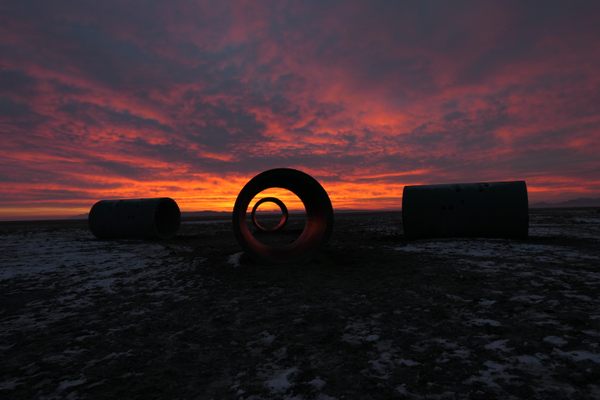
Who Tweeted That?
A field guide to the wild and wonderful world of birding in California.
No matter where you are as you read this—on your couch, in your car, in a park, at the office—you’re likely not far from some birds. Go ahead, check: look up, or walk to the nearest window, and see how long it takes until you hear a tweet tweet or see a winged friend swoop through the sky. Observe these sights and sounds for a minute or two. Congratulations! You just did some bird watching.
It’s easy to think of bird watching, or birding, as something reserved for hardcore hobbyists, people with expensive binoculars around their necks who can identify a yellow-billed magpie from the first syllable of its song. In reality, it’s a remarkably accessible activity that’s more akin to just paying attention than playing a game of Jeopardy. And in California, which is home to more species of birds (over 660) than any other state, it’s one of the most approachable ways to connect with your surroundings. And because it requires little more than eyes and ears, it’s the perfect activity for travelers and nature enthusiasts of all ages.
START HERE
If you’re new to birding, the most important first step is “just getting outside,” says Ryan Phillips, a Bay Area-based wildlife biologist who leads tours through NorCal Birding. “The cool thing about birds is that they’re everywhere. Any habitat you go into, even urban areas, there are birds everywhere, and they’re accessible by sound and by sight.” Once you’re outdoors near some birds, the next step is to ask yourself a simple pair of questions, Phillips says: What do you hear? What do you see?

This is how Phillips approaches birding with his 7-year-old daughter, and it’s a great way to start whether you’re an adult or a kid. Paying attention to bird sights and sounds is the first step to opening your mind to the wild world of birds both large and small, exotic and mundane.

While you might imagine some idealized version of “nature” to be the only place to go birding, Phillips says that cities can be an excellent place to start. “I tell people, just walk around your neighborhood and listen and look—you’ll be surprised at what you find,” he says. “You may find 30 species just turned around your house in like a week.” City parks are an excellent place to observe birds, too.
GEAR UP
While your eyes and ears are all you really need to get to know the birds around you, Phillips recommends two other pieces of equipment for amateur birders: a pair of binoculars, and a field guide or app. Binoculars will help you see the birds in detail, and can expand your vision of reality in really exciting ways. (He recommends Celestron Nature for kids 6+, and the Celestron Outland for an entry-level adult option.)
PHONE A FRIEND
Once you begin to observe the birds around you and all their fascinating quirks and habits, you’ll likely want to know just exactly what you’re looking at. Traditional guides offer a wonderfully analog option; Phillips recommends the Sibley Guide, written and illustrated by birder and artist David Sibley. Of course, if you’d rather travel light and get some extra help with bird identification, there are plenty of birding apps that can help open up the avian universe to you.
Phillips likes birding apps, which can identify a bird through the sound recorded on your phone. “When I started birding, you had a field guide and you just looked at birds and observed them and tried to identify them and got it wrong,” Phillips said. “Now, it’s changed so dramatically—apps can tell you what that singing bird is, and it’s a nice way to connect people [with the outside world].”
EXPLORE THE STATE
California is one of the country’s best spots for birding, thanks to its biodiversity. While you really can’t go wrong in terms of where you might see some fascinating birds, Phillips shared some of his favorite birding spots in the state to help you plan your first—or your next—birding trip.

Joshua Tree National Park
“For desert birding, I love Joshua Tree,” Phillips said. The namesake yucca palms are often the draw to this park in the Mojave desert, but it’s also an area rich in biodiversity—and that includes birds. Perhaps the most striking bird to see here is the famed roadrunner which, while able to fly, often runs to get where it’s going. It’s an exciting spotting for birders of all ages. Other notable birds in the park include the dramatically crested Gambel’s Quail and the cactus wren, which makes its nests atop the desert’s cactus species.

Pinnacles National Park
One of Phillips’ go-to strategies for interesting kids in birding is to get them focused on nests. Once a kid can spot and observe a nest, they’re able to observe far more about a bird than simply what it looks and sounds like. Plus, we can all agree that baby birds—which hatch in the spring—are adorable. A particularly interesting place to spy for nests is Pinnacles National Park, where the California Condor, which was once extinct in the wild, has been reintroduced and is thriving. These large birds in the vulture family have striking black plumage and featherless heads, which help them keep their feathers clean while they feed on carrion.

Loma Prieta
This is a lesser-known birding spot, but one of Phillips’ favorites. It’s the highest peak in the Santa Cruz mountains, and therefore offers an amazing view of migration patterns, and some rare California birds. “It’s one of the only sites in the region where you can see the Black Chin Sparrow. And then there’s the Bell Sparrow, which is endemic to California and breeds up there.” It’s also one of the only places where you can find the Purple Martin, with its striking blue feathers.
Golden Gate Park
It’s easy to assume that a city wouldn’t be the best place to go birding, but Phillips loves San Francisco’s Golden Gate Park, where you might see dozens of species in a couple hours. And sometimes, you’ll see dozens of birds drop down from the sky at once. “You’re surrounded by this urban area, but you have this unique habitat with lakes and ponds and riparian areas,” he says of the park. “It’s a really cool migrant trap where these birds are passing through and they stop over to feed, and this is one of the spots where they get trapped. Sometimes you’ll get what we call a fallout, where all these birds just drop outta the sky to feed and then continue their migration.”

Bolsa Chica Ecological Preserve
This Southern California spot beloved by birders is another one of Phillips’ favorites. Here, along a coastal estuary, you can spot over 200 species of birds, including peregrine falcons and osprey, or the Great Egrets that line up along the water’s edge. Like Loma Prieta and Golden Gate Park, this is an important migratory spot for many species.
Now that you know a little more about the birds of California and where to find them, it’s time to step outside—binoculars or no binoculars—and see them for yourself. Whether you’re planning a birding-themed road trip or simply headed to your local park to familiarize yourself with your avian neighbors, you’ll be thrilled by how easy it is to look up, listen, and learn.
This post was sponsored by Visit California. Learn More.














Follow us on Twitter to get the latest on the world's hidden wonders.
Like us on Facebook to get the latest on the world's hidden wonders.
Follow us on Twitter Like us on Facebook